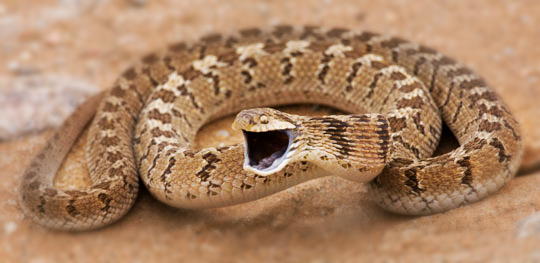 |
| Photograph by Juan Ponn |
All this week: the Battle of the Close-up Photography Tips: Juan Pons vs. me!
Hey, this is all in good fun!
Away we go!
Juan: Maintain eye level with your subject.
When photographing wildlife up close it is essential to maintain eye level with your subject. As human beings we are used to seeing the world from the 5ft - 6ft view point, so shots from this point of view oftentimes end up looking ordinary. Getting down low, up high, or sideways in order to establish eye level with your subject is a sure-fire way to establish a connection between the viewer and the subject.
By the why this is not strictly a close-up photo tip, this tip applies to just about any subject or composition that includes a subject with eyes. Sometimes you can even get a little lower than your subject to make them even more impressive.
I shot the copperhead snake above with a Canon EOS 40D and a Canon EF 180mm Macro lens at F/11 and 1/100th of a second at ISO 800. I was lying down on my belly about 8 feet away from the snake. Not something I recommend you do with a poisonous snake like this copperhead. Although I am not all that fond of snakes, this fellow was very mellow and was not threatened at all with my presence.
By the why this is not strictly a close-up photo tip, this tip applies to just about any subject or composition that includes a subject with eyes. Sometimes you can even get a little lower than your subject to make them even more impressive.
I shot the copperhead snake above with a Canon EOS 40D and a Canon EF 180mm Macro lens at F/11 and 1/100th of a second at ISO 800. I was lying down on my belly about 8 feet away from the snake. Not something I recommend you do with a poisonous snake like this copperhead. Although I am not all that fond of snakes, this fellow was very mellow and was not threatened at all with my presence.
• • •
 |
| Photograph by Rick Sammon |
Me: I agree with Juan on both tips - as illustrated by both of these photographs. :-)
 |
| Photograph by Captain Jack Leggett |
And when it comes to getting too close, you don't always need to use a true macro lens to get a nice close-up shot. I used my Canon 100-400mm IS to take the full-frame shot of the snake.
To draw more attention the subject, darken and blur the area around the subject. Also, increase the contrast of the subject, and not the surrounding area. Basically: think and work selectively.
To draw more attention the subject, darken and blur the area around the subject. Also, increase the contrast of the subject, and not the surrounding area. Basically: think and work selectively.
Also, if you want to get closer than a lens allows (minimum focusing distance) use an extension tube:
When it comes to extension tubes, you get what you pay for. No doubt. Same with tele-converters - and of course lenses.
If you like this post, please share it with a friend. All you have to do is click the twitter icon below.
For more info on close-up photography, and photography in general, check out my apps. Click here to start the photo fun! Juan and I developed Butterfly Wonders (which features a section on close-up photography) and Life Lesson We Can Learn From Mother Nature together.
If you like this post, please share it with a friend. All you have to do is click the twitter icon below.
For more info on close-up photography, and photography in general, check out my apps. Click here to start the photo fun! Juan and I developed Butterfly Wonders (which features a section on close-up photography) and Life Lesson We Can Learn From Mother Nature together.
• • •
Explore the light,
Rick

